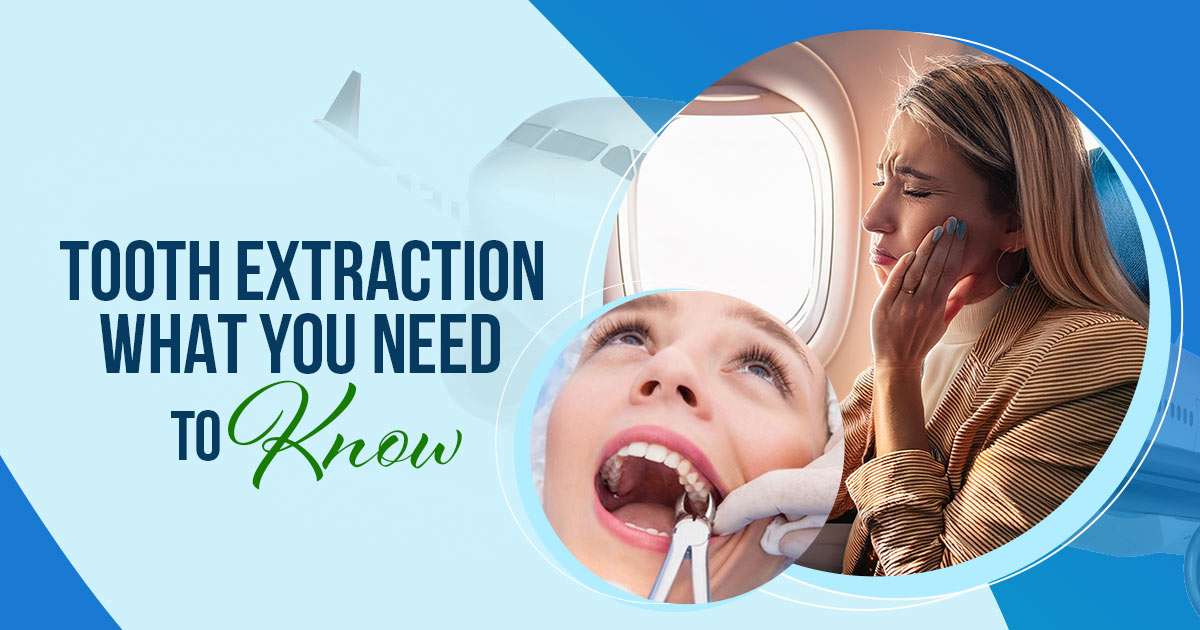Flying After Tooth Extraction: What You Need to Know

Flying after a tooth extraction can be a concern for many individuals, especially if travel plans are already in place. Knowing the effects of air travel following dental procedures is critical for a successful recovery.
Can you fly after tooth extraction?
Yes, you can fly after a tooth extraction. But most dentists suggest waiting 24 to 48 hours before flying. This time helps your body start healing and lowers the risk of problems caused by changes in altitude and cabin pressure.
On the other hand, you can fly after wisdom teeth removal, but it’s important to wait and take precautions to ensure a safe and comfortable journey. Dental professionals recommend that you wait 48 to 72 hours before flying. This allows time for initial healing and helps avoid complications related to pressure changes in the cabin.
Factors to Consider Before Flying After Tooth Extraction
Before booking a flight after a tooth extraction, there are several important factors to consider to ensure a smooth and comfortable journey:
- Type of Extraction: The complexity of the extraction affects how soon you can fly. For a simple tooth extraction, the recovery time might be shorter than for more complex procedures like wisdom teeth removal.
- Recovery Time: It is critical to give your body time to recuperate. Typically, healing after a tooth extraction takes about one to two weeks. During this time, you must strictly adhere to your dentist’s aftercare instructions.
- Swelling and Pain: Common after tooth extraction are swelling and pain. Flying with significant discomfort might worsen these symptoms. Ensure that your pain is manageable and that swelling is under control before booking your flight.
- Pressure Changes: Airplane cabins are pressurized, but the pressure changes during takeoff and landing can still impact your healing area. If you’re still recovering, this pressure change might cause additional discomfort.
- Medical Advice: Always check with your dentist or oral surgeon before embarking on any trip plans. They can offer tailored advice about flying following tooth extraction based on your personal scenario.
How long should you wait to fly after having a tooth pulled?
Most dentists recommend waiting at least 48 hours after a tooth extraction before flying. This gives your body time to start healing and helps avoid complications. However, recovery times can vary based on a few factors:
- Type of Extraction: Simple extractions usually heal faster than more complex ones, like wisdom teeth removal, which often takes longer to heal.
- Personal Health: If you have health issues or complications during recovery, you might need to wait longer before flying.
- Post-Operative Care: Following your dentist’s care recommendations carefully can also influence how soon you heal.
Tips for Flying After Tooth Extraction
If you find yourself needing to fly shortly after wisdom teeth removal or any tooth extraction, consider the following tips to help ensure a more comfortable journey:
- Plan Ahead: Ideally, schedule your flight a few days after the extraction. This gives your body time to begin recovering and lowers the danger of difficulties during the flight.
- Follow Aftercare Instructions: Follow your dentist’s aftercare instructions, which include taking medications as prescribed, applying cold packs to minimize swelling, and practice good dental hygiene.
- Stay Hydrated: Drink plenty of fluids before and during your flight to stay hydrated and aid in recovery.
- Bring Necessary Medications: Keep all prescribed medications and pain relievers with you during the flight. Ensure they are in their original packaging to avoid issues with security.
- Avoid Hard Foods: To avoid irritation, eat soft meals and refrain from chewing on the side where the extraction was conducted.
- Rest During the Flight: Use the flight time to rest and relax. Avoid vigorous activity that may interrupt the healing process.
Managing Discomfort During the Flight
If you experience discomfort during your flight, consider these strategies:
- Use Pain Relief: Take over-the-counter pain relief if recommended by your dentist. Follow dosage instructions carefully.
- Apply Ice: Use an ice pack to reduce swelling. You can ask flight attendants for a small ice pack or use a frozen gel pack wrapped in a cloth. Bring a cold compress to help with swelling, but make sure to inform TSA agents during airport screening.
- Stay Calm: Stress and anxiety can increase pain perception. Practice relaxation techniques to stay calm during your flight.
What to Watch Out For
While flying after tooth extraction is generally safe, be aware of signs that may indicate a problem. If you have these symptoms, contact your dentist or seek medical assistance:
- Severe pain does not better with medicines.
- Excessive bleeding or edema.
- Having difficulty breathing or swallowing.
- Symptoms of infection, such as fever or a bad taste in your mouth
Heal First Before Flying After Tooth Extraction
You can fly after a tooth extraction, but it’s best to wait 24 to 48 hours to give your body time to start healing. For wisdom teeth removal or more complicated extractions, wait 48 to 72 hours. Pay attention to how you feel and follow your dentist’s instructions to avoid issues. By planning ahead and taking care of yourself, you can have a more comfortable flight and help your recovery go smoothly.

